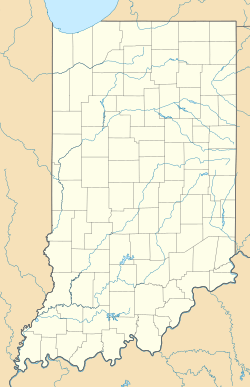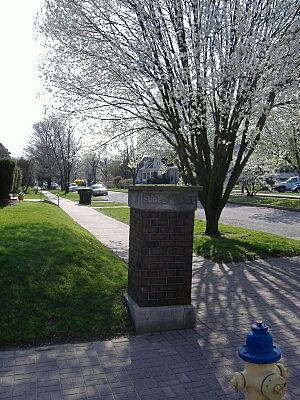Shelby Place Historic District facts for kids
Quick facts for kids |
|
|
Shelby Place Historic District
|
|

Houses on the northern side of the street
|
|
| Location | 1500 & 1600 blocks of Shelby Pl., New Albany, Indiana |
|---|---|
| Area | 4.3 acres (1.7 ha) |
| Built by | Stephen Day & Sons |
| Architectural style | Queen Anne, Colonial Revival |
| NRHP reference No. | 08000190 |
| Added to NRHP | March 19, 2008 |
The Shelby Place Historic District is a special neighborhood in New Albany, Indiana. It's about one mile north of the Ohio River, which flows across from Louisville, Kentucky. This district includes homes on the 1500 and 1600 blocks of Shelby Place. It was added to the National Register of Historic Places because of its unique and old building styles. Right next to it, to the east, is New Albany High School.
Contents
Exploring Shelby Place's Homes
Shelby Place is known for its beautiful old houses. Most of the homes here are built in the Bungalow style. But you can also find other cool designs. These include Queen Anne, Dutch Colonial Revival, American Foursquare, and even one Prairie-style house.
What Makes it Historic?
In total, 38 buildings and one special spot help make this district historic. These are called "contributing" buildings because they add to the area's history. There are also 14 buildings and one structure that are "non-contributing." This means they were built later or changed too much to be part of the original historic feel.
Most of the historic homes were built between 1907 and 1925. A lot of them, about 75%, were built quickly in 1912 and 1913. Shelby Place started to grow in 1906. This was when New Albany was getting back on its feet after a tough time, thanks to its woodworking factories. Even today, the district still looks much like it did back then. Unlike other areas nearby, Shelby Place has a wider street with a grassy area in the middle.
Special Features of the District
One unique feature of the district is its eastern entrance. It has two tall, square brick columns. These columns are about five feet high and sit on concrete bases. They are original to the neighborhood. Both columns have concrete tops that say "Shelby Place." There used to be two similar columns at the western entrance. But now, only small pieces of the southwestern column remain, and the northwestern one is completely gone.
Shelby Place and Major Events
The homes in Shelby Place have seen a lot of history. They have survived some big events that affected New Albany.
Surviving Natural Disasters
On March 23, 1917, a powerful tornado hit New Albany. It caused a lot of damage in the city. But luckily, it just barely missed Shelby Place. The district had only a little damage, and no buildings were lost.
Later, in 1937, a huge flood from the Ohio River caused some flooding in Shelby Place. However, the houses on the south side of the street were on higher ground. This meant they didn't get as badly flooded as other parts of New Albany.
Becoming a Historic Landmark
People recognized how special Shelby Place was many years ago.
The Path to Recognition
In 1994, a study looked at the buildings in Shelby Place. It found that the neighborhood could become a National Register historic district. This is a big honor for a place.
Then, in 2006, the Indiana Department of Natural Resources gave New Albany a grant. A grant is like a gift of money for a special project. This grant of $6,150 helped prepare Shelby Place and two other neighborhoods, Cedar Bough Place Historic District and the DePauw Avenue Historic District, to be added to the National Register. The DePauw Avenue district has similar house styles to Shelby Place, but its homes are usually larger and show more different architectural designs. All three neighborhoods were officially added to the National Register of Historic Places on March 19, 2008.




